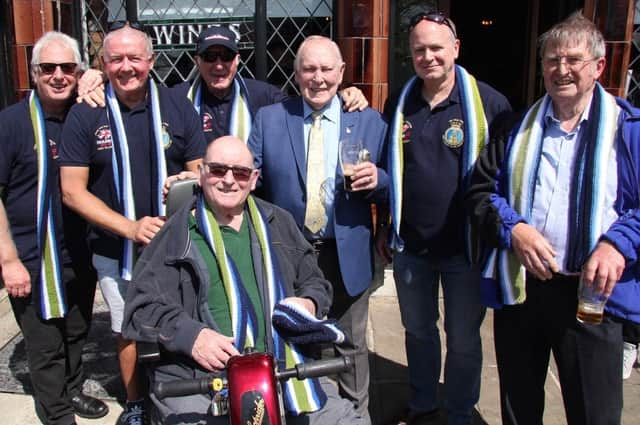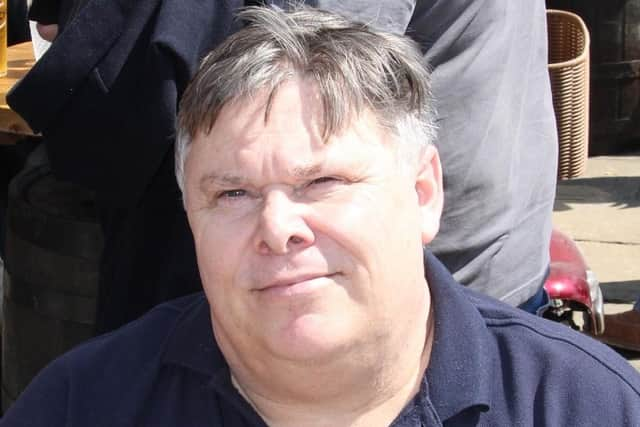The Lucky To Be Alive bunch – Falklands War veterans stage latest reunion in Portsmouth


The weather was perfect so everyone located outside in a reserved area saved by the landlord and landlady, the fantastic Keith and Maz, who also laid on a free buffet for the boys.
HMS Glasgow was in Gibraltar after being on exercise and the ship’s company thought they would be heading for home. Rob Guyett was due to retire after 26 years service on his arrival in Portsmouth a few months later. Little did he know that his retirement was to be delayed.
Advertisement
Hide AdAdvertisement
Hide AdA signal was received telling the ships’ commander, Captain Anthony Hoddinott, to get the ship down south.


Rob tells me that the Glasgow was the first ship to reach Ascension Island where they waited for the fleet to assemble. Once all the ships were formed into a fleet they headed for the Falklands, the Glasgow being the first to arrive in the Total Exclusion Zone (TEZ) around the islands.
LTBAD is held on the anniversary of the day when HMS Glasgow was struck by a 1,000lb bomb during the conflict from an Argentine fighter bomber.
The bomb entered the ship on the starboard side in the engine room, two feet above the waterline, passing through the ship and destroying everything in its path before exiting the port side a foot above the waterline.
Advertisement
Hide AdAdvertisement
Hide AdWith the greatest of luck, the bomb was duff and failed to explode.
You must remember, with the speed of the bomb after it left the aircraft, the bomb passed through the Glasgow in less time than it took you to read just a few words of this article.
The bomb damaged the diesel tank, with the oil entering the bilge tanks before the leak was stopped and a very dangerous situation brought under control.
The ship’s engineers frantically worked to gain control, redistributing electrical power and making sure the weapons systems were not affected.
Advertisement
Hide AdAdvertisement
Hide AdAfter pumping out the oil and making repairs to machinery and the ship’s systems, the Glasgow was brought back into operation.
The ship was not only lucky to have had a failed bomb hit her, another bomb from one of the three fighters hit the sea and, like a child’s flat stone skimming on a local pond, so the same thing happened to this bomb.
Gunners Graeme ‘Woody’ Wood and Tony Borgioli were at their station manning Oerlikon 20mm cannons.
‘We looked to starboard and saw three of the fighters approaching,’ recalled Graeme. ‘Then the first one dropped its bomb. It hit the water, skimmed up into the air, turning turtle like head over heels, it flew over the top of the ship. Another dropped astern of the ship.
Advertisement
Hide AdAdvertisement
Hide Ad‘It was then that the third aircraft dropped the duff bomb.’
I am glad to say that there was no loss of life during the incident.
A further incident entailed when an 18-year-old sailor in the operations room saw something approaching on his screen. It was deemed ’spurious’, meaning it could have been a flock of seagulls, but Captain Hoddinott was having none of it and took the ship into action stations.
Turning the ship, an Exocet missile failed to hit the Glasgow but it chased its next victim, HMS Sheffield, and we all know the fatal damage that occurred (20 deaths).
Advertisement
Hide AdAdvertisement
Hide AdAfter the bombing incident the Glasgow remained on station for another ten days as guard ship and then returned to Portsmouth, the first ship home.
Even then there was an impatient wait. The Glasgow arrived at Spithead about 10.30pm, too late to enter the naval base. She had to anchor with the lights of Portsmouth just a short distance away.
She eventually tied up at Fountain Lake Jetty at 4.30am, to be greeted by cheering family and friends.
Although Rob was about to leave the service after 26 years, many of the crew were just beginning theirs.
Advertisement
Hide AdAdvertisement
Hide AdTwo of the youngest were Mike Heidstrom and Wayne Bentley, both aged 17, along with CRE Alan Sutherland, the oldest on the ship aged 41.
Speaking on a personal note, I have never interviewed such a superb bunch of ex-servicemen before. A truly superb group of men.
*In the photographs of the ship’s company, you will see several of them wearing scarves. These are not scarves that can be purchased in any shop.
Instead, they are awarded to men who are Falklands War veterans and have been awarded the South Atlantic Medal. They are awarded to any member of the armed forces who were ‘down south’ from April 2 to October 20 1982.
Advertisement
Hide AdAdvertisement
Hide AdThe idea was instigated by Mrs Rachel Simons (nee Bennett), a native of the Falkland Islands. She came to the UK in 1984 aged 13 and now lives in Cumbria.
The idea came to her to knit scarves in the colours of the medal ribbon to say a ‘thank you’ to the men and women who brought peace and freedom back to the islands.
There are 75 scarf makers worldwide, who have made over 1,000 scarves to date.
Each scarf has 258 stitches in length to commemorate all those who died, including three civilian women killed in Port Stanley.
The scarves can also be awarded to widows of the fallen.
Advertisement
Hide AdAdvertisement
Hide Ad‘Scarves for the Falklands Veterans’ have chosen to support the Falklands Veterans Foundation Charity.
The scarves take eight hours of work and the wool is obtained by wool donations and also cash donations.
During the last Remembrance Service at the Cenotaph in Whitehall, he scarves were noticed by the current King Charles and Prince Edward, who asked the men about the neckwear.